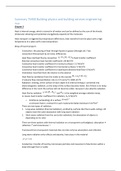Summary
Summary 7S4X0 Building physics and building services engineering
- Course
- Institution
Clear summary of the content of the course Building physics and building services engineering that contains all the important concepts and theories you need to know for good study results.
[Show more]



